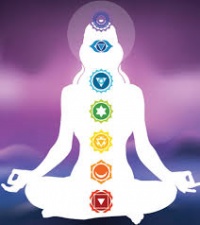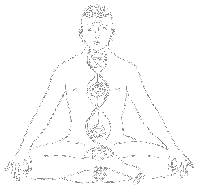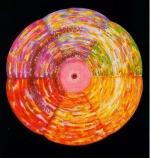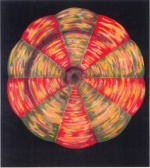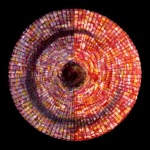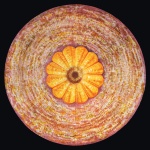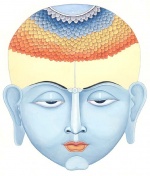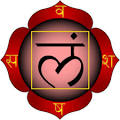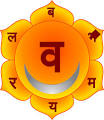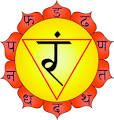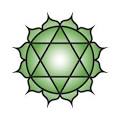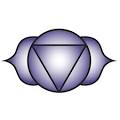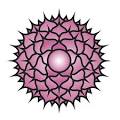Chakras: Difference between revisions
| Line 303: | Line 303: | ||
===Articles=== | ===Articles=== | ||
*[https:// | * [https://theosophy.world/encyclopedia/chakra Chakra] at Theosophy World | ||
===Reading list=== | ===Reading list=== | ||
Revision as of 21:15, 7 April 2020
The word chakra is Sanskrit (चक्र) for "wheel" and refers to energy centers that exist in the physical, emotional, and spiritual bodies. These force centers are points of connections at which energy flows from one body of a man to another. At each chakra, the concentrated energy spins around a central point, like a wheel spinning around an axle. Clairvoyants can see them in the etheric double. All these wheels are perpetually rotating and a force from the higher world is always flowing into them – in the undeveloped person usually sluggishly, while in a more evolved person they may be glowing and pulsating.[1]
Each of the chakras deals with a different aspect of human experience and produces a particular state of consciousness. The chakras also involve a hierarchy of needs, from physical and emotional to intellectual and spiritual. These energy centers have been correlated to colors, organs, and the Kabbalistic Tree of Life.
Various traditions have different views about the number and exact location of the chakras. Some chakras are considered major, some minor, but most traditions refer to seven chakras that lie along the length of the spine, from the first chakra at its base to the seventh chakra about the crown of the head.[2]
Introduction
According to many Tantric texts, the human body contains 72,000 nadis (tubular organs) that channel prana (life force) to every cell.
Three nadis are of particular interest. The sushumna runs from the base of the spine to the crown of the head, passing through each of the seven chakras in its course. It is the channel through which kundalini shakti (the latent serpent power) rises up from its origin at the muladhara (first or root) chakra to its true home at the sahasrara (seventh or thousand-fold) chakra at the crown of the head. In subtle body terms, the sushumna nadi is the path to enlightenment.
The ida and pingala nadis spiral around the sushumna nadi, crossing each other at every chakra. Eventually, all three nadis meet at the ajna (sixth) chakra.[3][4][5]
The anatomy of the chakras has been described in Indian and Tibetan tantric literature. The seven etheric chakras, which are very important for the health of the physical and etheric bodies, have their counterparts on the astral and mental levels. Chakras are both the transmitters and the transformers of energy from field to field. Their mechanism synchronizes the emotional, mental and the etheric energies. The chakras reveal a person’s quality of consciousness and degree of personal abilities and development. Each of the centers has special links to certain organs as well as with certain states of consciousness.[6]
Mme. Blavatsky teachings
The founder of the Theosophical Society, Helena Petrovna Blavatsky, wrote:
Our seven Chakras are all situated in the head, and it is these Master Chakras which govern and rule the seven (for there are seven) principal plexuses in the body, and the forty-two minor ones to which Physiology refuses that name.[7]
And if the term plexus, in this application, does not represent to the Western mind the idea conveyed by the term of the anatomist, then call them Chakras or Padmas, or the Wheels, the Lotus Hearts and Petals. Remember that Physiology, imperfect as it is, shows septenary groups all over the exterior and interior of the body; the seven head orifices, the seven “organs” at the base of the brain, the seven plexuses (the pharyngeal, laryngeal, cavernous, cardiac, epigastric, prostatic, and the sacral plexus), etc., etc. . . . If asked whether the seven plexuses, or Tattvic centres of action, are the centres where the seven rays of the Logos vibrate, I answer in the affirmative, simply remarking that the rays of the Logos vibrate in every atom, for the matter of that.[8]
The Tântrists do not seem to go higher than the six visible and known plexuses, with each of which they connect the Tattvas; and the great stress they lay on the chief of these, the Mûladhâra Chakra (the sacral plexus), shows the material and selfish bent of their efforts towards the acquisition of powers. Their five Breaths and five Tattvas are chiefly concerned with the prostatic, epigastric, cardiac, and laryngeal plexuses. Almost ignoring the Agneya, they are positively ignorant of the synthesizing pharyngeal plexus. But with the followers of the old school it is different. We begin with the mastery of that organ which is situated at the base of the brain, in the pharynx, and called by Western anatomists the Pituitary Body.[9]
According to Charles Leadbeater
Charles Webster Leadbeater wrote an analysis of chakras based on his own clairvoyant experiences.
Root chakra
The first chakra, at the base of the spine, has a primary force which radiates out in four spokes. It is alternately red and orange in hue, with hollows between them.[10]
Spleen chakra
The second center at the spleen is devoted to the specialization, subdivision, and dispersion of the vitality which comes to us from the sun. [11]
This does not correspond to the Hindu svādhiṣṭhāna chakra, usually listed as the second one, and connected to the sexual organs:
The spleen chakra is not indicated in the Indian books; its place is taken by a centre called the Svadhishthana, situated in the neighbourhood of the generative organs, to which the same six petals are assigned. From our point of view the arousing of such a centre would be regarded as a misfortune, as there are serious dangers connected with it. In the Egyptian scheme of development elaborate precautions were taken to prevent any such awakening.[12]
Regarding its function, Leadbeater wrote:
The second centre, the splenic (Plate II), at the spleen, is devoted to the specialization, subdivision and dispersion of the vitality which comes to us from the sun. That vitality is poured out again from it in six horizontal streams, the seventh variety being drawn into the hub of the wheel. This centre therefore has six petals or undulations, all of different colours, and is specially radiant, glowing and sunlike. Each of the six divisions of the wheel shows predominantly the colour of one of the forms of the vital force--red, orange, yellow, green, blue and violet.[13]
The effects of its awakening were described as follows:
When the second of the etheric centres, that at the spleen, is awakened, the man is enabled to remember his vague astral journeys, though sometimes only very partially. The effect of a slight and accidental stimulation of this centre is often to produce half-remembrance of a blissful sensation of flying through the air.[14]
The third chakra at the navel or solar plexus receives a primary force with ten radiations, so it vibrates in a way to divide itself with ten petals.[15]
Heart chakra
The fourth chakra at the heart is of a glowing golden color, and each of its quadrants is divided into three parts, which gives it twelve petals.[16]
Throat chakra
The fifth chakra at the throat has sixteen spokes and therefore sixteen apparent divisions.[17]
Brow chakra
The sixth chakra, between the eyebrows, has the appearance of being divided into halves. Leadbeater believed that is the reason that this center is mentioned in Indian books as having only two petals.[18]
Although in Hinduism the Ājñā chakra is traditionally connected to the Third Eye, Mme Blavatsky did not support the idea that this eye was really between the eyebrows.[19] Accordingly, C. W. Leadbeater said that the brow chakra is connected with the pituitary gland and not with the pineal, which is regarded are the real "third eye" in Theosophy.[20]
Leadbeater described the brow chakra as follows:
The sixth centre, the frontal (Plate IX), between the eyebrows, has the appearance of being divided into halves, one chiefly rose-coloured, though with a great deal of yellow about it, and the other predominantly a kind of purplish-blue, again closely agreeing with the colours of the special types of vitality that vivify it. Perhaps it is for this reason that this centre is mentioned in Indian books as having only two petals, though if we are to count undulations of the same character as those of the previous centres we shall find that each half is subdivided into forty-eight of these, making ninety-six in all, because its primary force has that number of radiations.[21]
Regarding its function, Leadbeater wrote:
When the sixth [chakra], between the eyebrows, becomes vivified, the man begins to see things, to have various sorts of waking visions, sometimes of places, sometimes of people. In its earlier development, when it is only just beginning to be awakened, it often means nothing more than half-seeing landscapes and clouds of colour. The full arousing of this brings about clairvoyance. The centre between the eyebrows is connected with sight in yet another way. It is through it that the power of magnification of minute physical objects is exercised. A tiny flexible tube of etheric matter is projected from the centre of it, resembling a microscopic snake with something like an eye at the end of it. This is the special organ used in that form of clairvoyance, and the eye at the end of it can be expanded or contracted, the effect being to change the power of magnification according to the size of the object which is being examined. This is what is meant in ancient books when mention is made of the capacity to make oneself large or small at will. To examine an atom one develops an organ of vision commensurate in size with the atom. This little snake projecting from the centre of the forehead was symbolized upon the head-dress of the Pharaoh of Egypt, who as the chief priest of his country was supposed to possess this among many other occult powers.[22]
Crown chakra
According to Leadbeater, the seventh center at the top of the head is, when stirred into full activity, the most resplendent of all and seems to contain all sorts of prismatic hues.[23]
C. W. Leadbeater connected the "crown chakra" with the pineal, which is regarded as the "third eye" in Theosophy.[24] He described this center as follows:
The seventh centre, the coronal, at the top of the head, is when stirred into full activity the most resplendent of all, full of indescribable chromatic, effects and vibrating with almost inconceivable rapidity. It seems to contain all sorts of prismatic hues, but is on the whole predominantly violet. It is described in Indian books as thousand-petalled, and really this is not very far from the truth, the number of the radiations of its primary force in the outer circle being nine hundred and sixty.... This chakra is usually the last to be awakened. In the beginning it is the same size as the others, but as the man progresses on the Path of spiritual advancement it increases steadily until it covers almost the whole top of the head. Another peculiarity attends its development. It is at first a depression in the etheric body, as are all the other, because through it, as through them, the divine force flows in from without; but when the man realizes his position as a king of the divine light, dispensing largesse to all around him, this chakra reverses itself, turning as it were inside out; it is no longer a channel of reception but of radiation, no longer a depression but a prominence, standing out from the head as a dome, a veritable crown of glory.[25]
Regarding its function, he wrote:
When the seventh centre is quickened, the man is able by passing through it to leave his body in full consciousness, and also to return to it without the usual break, so that his consciousness will be continuous through night and day. When the fire has been passed through all these centres in a certain order (which varies for different types of people) the consciousness becomes continuous up to the entry into the heaven-world at the end of the life on the astral plane, no difference being made by either the temporary separation from the physical body during sleep or the permanent division at death.[26]
The Eastern Chakra System
The Theosophist and author Kurt Leland writes about the Eastern system in his book Rainbow Body: A History of the Western Chakra System from Blavatsky to Brennan: [27]
The form of the Eastern system most familiar in the West appeared in The Secret Serpent, a 1919 publication by Sir John Woodroffe (1835-1936), a British judge on the high court of Calcutta. This book was an exposition of Tantra as it related to the chakras. The Eastern systems consisted of three primary nadis (more about this in the Introduction above)
Mūlādhāra chakra (root support), also called guda (rectal) chakra.
Svādhiṣṭhāna chakra (own place), also called medhra (genital chakra).
Maṇipūra chakra, also called nābhî (navel) chakra.
Anāhata chakra (unstruck sound); also called hrdaya (heart) chakra. Certain types of yoga involve focusing on subtle sounds that become audible when one meditates on the heart center. Such sounds are considered to be modifications of a universal sound current set in motion by the absolute (Brahman) when the manifest universe was created.
Viśuddha chakra (purifying); also called kantha (throat) chakra. [28]
Ājñā chakra (command); also called bhrūmadhya (brow) chakra. It is said that this is the chakra through which the commands of the guru come. Alternatively, it represents manas (mind) and its mastery indicates that the minds is under the practitioner’s command.[29]
Talking about the ājñā chakra, Swami Satyananda Saraswati said:
There is a certain problem with the awakening of the other chakras. Each one contains a store of karmas or samskara, both good and bad, positive and negative, painful and pleasant. The awakening of any chakra will definitely bring to the surface an explosion or expression of these karmas, and of course, not everybody is prepared or ready to face them. Only those who have reason and understanding are able to cope. Therefore it is said that before you start awakening and manifesting the great force, it is best to purify the mind at the point of confluence. Then, with a purified mind, you can awaken the other chakras.[30]
He also said:
Ajna chakra is the point of confluence where the three main nadis or forces - ida, pingala and sushumna merge into one stream of consciousness and flow up to sahasrara, the crown center.[31]
Sahasrāra chakra (thousand-fold); sometimes referred to by its location: mūrdhān (head/cranial vault). The usual English translation is “thousand-petaled lotus”. [32]
The Chakras and the Endocrine Glands
Modern literature from both the Western and Eastern cultures highlights the connection between the chakras and the endocrine and nervous systems, as well as organs. Alice Bailey outlined the connections between the chakras and the biology of the human body, and other people were responsible for describing chakra/gland correspondences: James Morgan Pryse, a student of Blavatsky; Herman Harold Rubin, a medical doctor; Bhagat Singh Thind, an early Indian teacher, Cajzoran Ali, who published a photographic manual of yoga postures, and Edgar Cayce.[33]
There are slight variations, but most often the chakras and glands are connected as a follows:
- First Chakra: Gonads (the testes in the male, the ovaries in the female)
- Second Chakra: Adrenals
- Third Chakra: Spleen
- Fourth Chakra: Thymus
- Fifth Chakra: Thyroids
- Sixth Chakra: Pituitary Gland
- Seventh Chakra: Pineal[34]
The main differences are often with the second and third chakra. For example, sometimes the third chakra is connected with the pancreas and sometimes with the adrenals.
Edgar Cayce connects the second chakra with the cells of Leydig which produce the androgen and testosterone in the presence of luteinizing hormones. According to Cayce’s model for health, the activity of the endocrine centers represents in the flesh what is happening in the mind and spirit. The centers function somewhat like valves in regulating the flow of the creative life-force into the physical body.[35]
Modern Yogic Interpretation
In modern yoga, the chakras have these correspondences:[36][37][38]
Mūlādhāra chakra (first or root chakra)
Location: Base of the body Element: Earth Color: Red Issues: Survival fear Areas of Body: Eliminatory system, legs and feet Balanced: Groundedness and safety Excessively open: Extreme materialism, running to greed and hoarding Blocked: Feeling insecure and disassociated from our body Archetype: Earth Mother Negative Archetype: Victim Demon: Fear Svādhiṣṭhāna chakra (second or sacral chakra)
Location: Four fingers below navel Element: Water Color: Orange Issues: Intimacy, emotions Areas of Body: Reproductive organs and pelvic area Balanced: Healthy sexuality and emotions; enthusiasm Excessively open: Weak boundaries Blocked: Tendency to be very rigid Archetype: (Physical) love Negative Archetype: Martyr, denying his/her own pleasure Demon: Guilt Maṇipūra chakra (third or naval chakra)
Location: Solar plexus Element: Fire Color: Yellow Issues: Self-esteem, ego, feelings of autonomy Areas of Body: Stomach, liver, small intestine Balanced: Healthy social roles Excessively open: Aggression in a bullying way Blocked: Selfless behavior motivated by personal worthlessness Archetype: Hero Negative Archetype: Servant or slave Demon: Shame Anāhata chakra (heart chakra)
Location: Heart Element: Air Color: Green Issues: Compassion, optimism/pessimism Areas of Body: Heart, lungs, shoulders, arm Balanced: Unconditional love Excessively open: Co-dependent love Blocked: Withdrawal from love, fear of being wounded Archetype: Healer Negative Archetype: Actor Demon: Grief Viśuddha chakra (throat chakra)
Location: Throat Element: Space Color: blue Issues: Communication, intuition Areas of Body: Throat, mouth Balanced: Inner directed Self Excessively open: Using speech as mechanism of control Blocked: Unable to communicate about important issues Archetype: Communicator, artist Negative Archetype: Silent child Demon: Lies Ājñā chakra
Location: Third eye Element: All Color: Violet Issues: Dedication to spiritual path; clarity and insight Areas of Body: The senses Balanced: Calm and focused Excessively open: Delusion Blocked: Denial what is seen Archetype: Seer, visionary Negative Archetype: Intellectual Demon: Illusion Sahasrāra chakra (crown chakra)
Location: Crown of head Element: Beyond Color: Crystal light Issues: Spiritual separation Areas of Body: Brain and nervous system Balanced: Unity consciousness Excessively open: Spiritual addiction Blocked: Limited in our ability to believe or have faith Archetype: Guru (within), sage Negative Archetype: Egotist (belief of being separate from others) Demon: Attachment
Music and the Chakra System
Theosophist and author Kurt Leland outlines in his book Music and the Soul the relationship between life force, the chakras, and elements of music, such as rhythm, harmony, melody, and form. [39]
First chakra, center of arousal (sound scores for film, dance, performance art, rhythmic music): It is associated with the Soma, or body consciousness and the lesson of the Soma is embodiment, which helps us become more fully focused in the physical body. The aspect of music that helps us with this is rhythm because it arouses our attention and holds it.
Second chakra, center of desire (ambient and minimal music): It is associated with the Participant, the part of us that takes action in the world. The lesson of the Participant is motivation, which spurs us into action. The aspect of music that motivates us to listen more deeply is the sensual quality of sound – its beauty – which he calls sonority.
Third chakra, center of intensity (dramatic music, like opera): It is associated with the Shadow, the part of us that blocks action. The lesson of the Shadow is identity which is often created through friction with other people and a sense of drama. The aspect of music that best represents this process is intensity.
Fourth chakra, center of expression (often the form of songs including the blues): It is associated with the Anima/Animus or the beloved. The lesson is union which helps us to overcome the separation from others involved in developing our identities. The aspect of the music that best represents this process is melody which allows us to express the pain of separation, the yearning for connection, and the elation of achieving union with the beloved.
Fifth chakra, center of well-being (dance music, from classical minuets to swing and rock and roll): It is associated with the Counterpart or friend. The lesson of the Counterpart has to do with discovering and fulfilling our life purpose, a project that often involves the support of friends, colleagues, and other social relations. The aspect of music that best represents this process is tempo – the speed of the music. The upbeat music of the fifth center is similar to that of the fourth chakra but speeded up.
Sixth chakra, center of command (symphonies and other large-scale compositions): It is associated with the part of us that sets the limits for our growth. The lesson is analysis, which allows us to determine which limits are supporting us “in”, and which are blocking us “from”, achieving our goals. The composer becomes the guru attempting to pass on his/her own degree of awakening through the medium of sound. The aspect of music that best represents this process is form. Form is the means by which a composer structures or limits a piece of music and commands our attention.
Seventh chakra, center of expanded consciousness (sacred music, including Gregorian chants): It is associated with the Witness, which has to do with memory. The lesson of the Witness is wisdom, which allows us to transform our experiences into lessons on the path of spiritual growth. The aspect of music that best represents it is what Kurt Leland calls macrorhythm – a way of organizing music into long swells of accumulating and dissipating energy. Music organized in this way has a transformative effect on the consciousness of a listener.
Kurt Leland adds one more center, the eighth center, which he calls the transpersonal chakra.
Eighth chakra, center of cosmic consciousness (buddhic music, relatively rare): It is associated with the Numen or soul. The lesson of the Numen is transcendence, which allows us to experience a sense of oneness with the divine. The aspect of music that best represents this process is something that Kurt Leland calls metarhythm – organizing music to create the impression of timelessness, or music that is unfolding beyond time. Music organized this way can open us to a sense of oneness with God or the universe. [40]
Online resources
Articles
- Chakra at Theosophy World
Reading list
- "Chakras" is a reading list developed by the Henry S. Olcott Memorial Library.
Audios
- Chakras by Stephen Hoeller
- The Inner Structure of Man and Its Effects on Daily Life by Dora Kunz
Video
- The Structure and Function of the Chakras by Dora Kunz and Shafica Karagulla
- "The Chakras: A Magical Mystery Tour" by Kurt Leland .
- Chakra Clairvoyance: Part 1 by Kurt Leland.
- Chakra Clairvoyance: Part 2 by Kurt Leland.
- Chakra Clairvoyance: Part 3 by Kurt Leland.
Notes
- ↑ Charles Webster Leadbeater, Annotations by Kurt Leland, The Chakras, (Wheaton, Ill: The Theosophical Publishing House, 2013), p. 1- 5
- ↑ Kurt Leland, "The Chakras: A Magical Mystery Tour," lecture presented on March 9, 2017. See YouTube.
- ↑ James Bailey, Discover the Ida and Pingala Nadis. August 28, 2007. https://www.yogajournal.com/yoga-101/balancing-act-2
- ↑ Charles Webster Leadbeater, Annotations by Kurt Leland, The Chakras, (Wheaton, Ill: The Theosophical Publishing House, 2013), 25-27.
- ↑ Kurt Leland, Rainbow Body: A History of the Western Chakra System from Blavatksy to Brennan, (Lake Worth, Fl: Ibis Press, 2016), 47-48.
- ↑ Shafica Karagulla, M.C. and Dora van Gelder Kunz, The Chakras and the Energy Fields, (Wheaton, Ill: The Theosophical Publishing House, 1989) 33-38.
- ↑ Helena Petrovna Blavatsky, Collected Writings vol. XII (Wheaton, IL: Theosophical Publishing House, 1980), 619.
- ↑ Helena Petrovna Blavatsky, Collected Writings vol. XII (Wheaton, IL: Theosophical Publishing House, 1980), 620.
- ↑ Helena Petrovna Blavatsky, Collected Writings vol. XII (Wheaton, IL: Theosophical Publishing House, 1980), 616.
- ↑ Leadbeater, 9.
- ↑ Leadbeater, 9.
- ↑ Leadbeater, 7, fn.
- ↑ Leadbeater, 12, fn.
- ↑ Leadbeater, 78.
- ↑ Leadbeater, 10.
- ↑ Leadbeater, 10.
- ↑ Leadbeater, 10.
- ↑ Leadbeater, 10-11.
- ↑ Helena Petrovna Blavatsky, The Secret Doctrine vol. II, (Wheaton, IL: Theosophical Publishing House, 1993), 295.
- ↑ Leadbeater, 10.
- ↑ Leadbeater, 13-14.
- ↑ Leadbeater, 79.
- ↑ Leadbeater, 11.
- ↑ Leadbeater, 10.
- ↑ Leadbeater, 14-15.
- ↑ Leadbeater, 80.
- ↑ Kurt Leland, Rainbow Body: A History of the Western Chakra System from Blavatksy to Brennan, (Lake Worth, Fl: Ibis Press, 2016), 47-51.
- ↑ Leland, "Rainbow Body," 47-51.
- ↑ Leland, "Rainbow Body," 47-51.
- ↑ Swami Satyananda Saraswati, Kundalini Tantra (Munger, Bihar, India: Yoga Publications Trust, 2001), Chapter 3.
- ↑ Swami Satyananda Saraswati, Kundalini Tantra (Munger, Bihar, India: Yoga Publications Trust, 2001), Chapter 3.
- ↑ Leland, "Rainbow Body," 47-51.
- ↑ Leland, Rainbow Body, 226-231.
- ↑ Leland, Rainbow Body, 226-234.
- ↑ Edgar Cayce, The Essential Edgar Cayce (New York, NY: Penguin Group, 2004), 37-38. Mark Thurston, editor.
- ↑ Kalashatra Govinda, A Handbook of Chakra Healing (Old Saybrook, Ct: Konecky & Konecky).
- ↑ Joseph and Lilian Le Page, Integrative Yoga Therapy: Yoga Toolbox (Santa Rosa, Ca.).
- ↑ Biff Mithoefer, The Yin Yoga Kit, (Rochester, Vt., Healing Arts Press).
- ↑ Kurt Leland, Music and the Soul, (Charlottesville, Va: Hampton Roads Publishing Company, 2005), xiii.
- ↑ Kurt Leland, Music and the Soul, 73-75.
